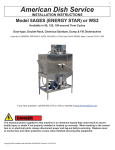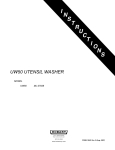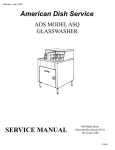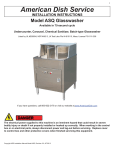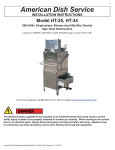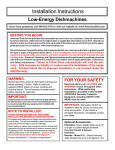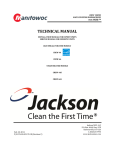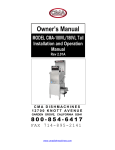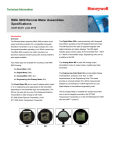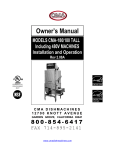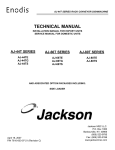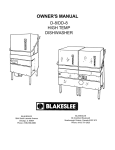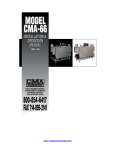Download Installation Manual AFES AFCES Energy Star
Transcript
1 American Dish Service INSTALLATION INSTRUCTIONS Model AF-ES, AFC-ES (ENERGY STAR) Available in 90, 120, 150-second Time Cycles Door-type, Single-Rack, Chemical Sanitizer, Dump & Fill Dishmachine Listed by UL, #E68594, NSF/ANSI 3, ASSE 1004 #933, LA Test Labs File M-780089, Mass. License P3-0111-306 If you have questions, call 800-922-2178 or visit our website at www.AmericanDish.com The electrical power supplied to this machine is an imminent hazard that could result in severe bodily injury or death if not properly installed or hooked up correctly. When working in the control box or on electrical parts, always disconnect power and tag-out before servicing. Replace cover to control box and other protective covers when finished servicing this equipment. Copyright ADS Installation Manual Model AF-ES, Revision 3.0, 6/7/2013 2 READ Manufacturer’s Manual before Using this Product. For your safety read and observe all cautions shown throughout these instructions. While performing installations described in this booklet, wear approved Personal Protective Equipment, including Safety Eye-Wear. CHEMICALS — There are potentially hazardous situations when working with industrial cleaning chemicals for dishmachines. See chemical manufacturer’s safe practices and MSDS sheets for handling and installing chemicals and supply containers. #1 BEFORE YOU BEGIN — American Dish Service provides this information as a service to our customers. Keep all instructions for future reference. ADS reserves the right to alter or update this information at any time. Should you desire to make sure that you have the most up-to-date information, we would direct you to the appropriate document on our web site: www.americandish.com. Set out below are the specifications and requirements that you must use and follow to properly install the type or types of equipment listed above. It is your obligation as the customer to ensure that the machine is installed safely and properly, and when completed, the machine is left in proper and safe working order. Electrical, Plumbing, and Chemical hookup should be performed by a qualified professional who will ensure that the equipment is installed in accordance with all applicable Codes, Ordinances, and Safety requirements. Failure to follow the installation instructions could void the warranty. ADS assumes no liability or control over the installation of the equipment. Product failure due to improper installation is not covered under the ADS Warranty. #2 FLUSH OUT — Do not install spray arms until machine is flushed with water. When this machine is turned on, it is normal for it to start and complete one cycle. First, fill and run a cycle. Do this before installing the spray arms. Draining the water will flush installation debris from the tank and pump; this prevents damage to spray arm bearings. To drain, pull the drain ball out of the sump. #3 WATER HEATERS — or boilers must provide the minimum temperature of 120°F required by the machine listed above and which demands a minimum of 35 gallons per hour. The recommended temperature range for optimal performance is 130-140°F. These specifications are for the dishmachine only, which typically accounts for 70% of a restaurant’s hot water demand. #4 IMPORTANT — The model of dishmachine listed in this document must be installed with space around the outside to allow for servicing of motor and scrap accumulator as well as a 4” space behind the machine from the wall. #5 INSPECT FOR DAMAGE — If you receive a damaged dishmachine, do not sign “Clear” but write “Damaged” on the documents. #6 LOOSE ELECTRICAL CONNECTIONS — Damage to equipment can occur if the following precautions are not observed. Before connecting power to the machine, check all electrical terminals in the control box. Screws can loosen in transit. Loose connections on high amp load terminals such as the pump motor will cause wire burning and component damage during operation and will not be covered under ADS warranty. Copyright ADS Installation Manual Model AF-ES, Revision 3.0, 6/7/2013 3 #7 “CLEAN CIRCUIT” means the electrical circuit breaker for the dishmachine supplies no other outlets, machines, or lights. GFCI outlets are not recommended for commercial dishmachines; ADS recommends that a single-rack machine be installed with the wire connection (hard-wired) directly from the circuit breaker. If a plug and socket are used to provide electrical power to a dishmachine in a commercial kitchen, then according to electrical code it must be a GFCI, but not all GFCIs are the same. They must be rated for the draw of the circuit. Reference NEC Article 210.8 GFCI Protection (B) Other Than Dwelling Units (2) Commercial and Institutional Kitchens. All 15 and 20A, 125V receptacles installed in kitchens, even those that do not supply the countertop surface, must be GFCI protected. #8 This equipment is considered an item of heavy use. It is not rated for outdoor use. ELECTRICAL SECTION The electrical power supplied to this machine is an imminent hazard that could result in severe bodily injury or death if not properly installed or hooked up correctly. Electrical—AF-ES, AFC-ES, (120 volt, 20 amp) Showing control tray installed in normal position Showing control tray lifted up to service pumps The power supply for 120 volts, 20amps, shall consist of two #10-12-gauge wires and one suitable green ground wire. The 20 amp breaker or 20 amp fuse must be on a clean circuit for only the machine. ADS has provided a junction box with a 7/8” hole for the 1/2” conduit that will bring the building’s electrical power to the machine. The junction box is attached to the back of the control box. Remove the junction box cover, attach the conduit and connect a black 120 volt supply wire to the black wire in the junction box. Connect a white neutral supply wire to the white wire in the junction box. When powered up, test the neutral wire to a ground source with a volt meter, it should read 0 to 6 volts. Test the black wire to a ground source, it should read 110-120 volts. Attach a building ground wire to the green ground screw located in the junction box and tighten all wires. Replace the junction box cover and control box lid. Label the 20 amp circuit breaker, “DISHMACHINE.” Copyright ADS Installation Manual Model AF-ES, Revision 3.0, 6/7/2013 4 Showing control box, chemical pumps, prime switches Ground screw in junction box Showing power connection box for 120v wiring Line connection spades for L1, Neu (arrow 1 & 2) THIS MACHINE DOES NOT USE A BOOSTER OR TANK SUSTAINER HEATER. IT IS RECOMMENDED THAT THIS EQUIPMENT BE INSTALLED USING A NEW CIRCUIT BREAKER. PLUMBING SECTION #1 TANKLESS water heaters can be problematic for commercial dishmachines. The ADS model AF-ES dishmachine requires the full cycle amount of water (.95 gallon) supplied within 7 seconds. It has been the experience of ADS that tankless supply systems require multiple units plumbed in sequence with a recirculation loop to achieve proper pressure and temperature. Check with the tankless water heater manufacturer, they may recommend a storage tank to guarantee proper flow and line pressure to the machine. Failure to provide adequate water quantity, pressure and temperature to the machine will cause the machine to function improperly and is not the responsibility of ADS. Improperly installing ADS equipment in this manner could void the warranty. All costs associated with providing an adequate water supply to the machine is the sole responsibility of the user. Copyright ADS Installation Manual Model AF-ES, Revision 3.0, 6/7/2013 5 #2 HOODS—Follow all local plumbing and mechanical codes. IMC 2012, section 507.2.2 requires Type II hoods for all commercial dishwashers except where the heat and moisture loads are incorporated into the building’s HVAC systems or dishwashing equipment designed with separate heat and moisture removal systems. The door-type, chemical sanitizing dishwasher in this manual is rated at 6753 Btu/h by UL Project #12CA71037, according to ASTM F1704-12 and ASTM F2474-09. This sensible and latent gain would typically require a half ton of AC. ADS DOES NOT SPECIFY BUILDING HVAC VALUES #3 DRAIN SIZE—Gravity drain lines are 2” pipe size. Do not use reducing adapters for drain lines, always use same diameter pipe or larger. Close pump petcocks if equipped. Showing ½” female pipe inlet, ball valve, y-line filter, water solenoid, ASSE approved air gap (backflow preventer) Typical name plate information Hot Water Connection WATER HEATER — Flush the building’s water lines before connecting to the dishmachine. Prior to connecting plumbing, level the machine by adjusting the feet at the bottom of each leg up or down. Water heaters or boilers must provide the minimum temperature of 120°F for this model of machine, which demands a minimum of 35 GPH for AF-ES series. Temperatures above 150°F exceed the operational design limits for this model. This model cannot be converted to high temp sanitizing by adding a booster. INLET FLEX HOSE — Domestic style 1/2” flexible braded hose should not be used to connect the dishmachine to plumbing. The ID of the plastic liner for this type hose restricts flow. Connect 1/2" male pipe thread (1/2” is the minimum allowable pipe size) of the hot water supply line to the 1/2" female pipe thread on the dishmachine’s water inlet manifold. SINK FAUCET — If the hot water line is also supplying the faucet of a pre-rinse sink, install check valves on both cold and hot water inlets to the faucet— to avoid cooling the water by cross-connection in the mixing head of the faucet. The hot water inlet manifold is located behind the AF-ES control box. The supply water must have a minimum of 120°F, but 130-140°F is recommended for best results. Copyright ADS Installation Manual Model AF-ES, Revision 3.0, 6/7/2013 6 Water Pressure for Filling Minimum pressure needed at the machine is 15 psi DURING the fill. This is called FLOW pressure. STATIC pressure readings can be misleading and may drop to “0” during fill. With flow pressures below 15 psi, additional measures will be needed to resolve the problem. The first suggestion is to run 3/4" pipe directly from the water heater to the dishmachine. If the problem persists, install a pressure bladder tank used for domestic well water; use a 5-gallon tank as a minimum, 10-gallon as maximum. Another option is to order a cam timer with longer cycle times but this will reduce hourly production rates. Simple Test For Water Pressure Empty the water out of the machine by lifting the drain ball, push the manual FILL button while counting the seconds to fill back up to the water level decal. If it takes more than 20 seconds to fill, there is not enough building pressure to operate the machine properly. Drain Requirements Showing ES bottom exit scrap box ES side exit scrap box w/no-hub Bottom view of side exit w/stud mounts To place the AF-ES scrap box correctly, remove from inside the machine’s cabinet and place under the sump. There are two holes in the frame to bolt the box into the operating position. To the rear of the box (depending on how it was ordered) there will be either side or bottom exit fitting that fits a rubber “no-hub” connector shipped inside the machine. This connector will fit 2” copper pipe or PVC tube. To prevent clogging, run drain lines as straight as possible. Do not run drain plumbing with tight radius elbows or 180° bends. The use of floor sinks for drains can cause flooding. Always run gravity drain lines downhill. Do not reduce the diameter of the pipe with adapters, always use 2” or larger. Copyright ADS Installation Manual Model AF-ES, Revision 3.0, 6/7/2013 7 Front view of scrap box installed position Side view of scrap box in operational position Rear view of installed side exit ES scrap box CHEMICAL FEEDERS SECTION You must wear approved safety eye-wear before connecting chemicals. Read the chemical manufacturer’s MSDS sheets. Chemicals can damage or corrode plumbing and stainless parts of the dishmachine. Do not run chemical lines over controls or plumbing. Always secure chemical lines and check regularly for leaks. If not properly handled, chemicals can cause serious bodily injury. In the event of chemical contact to skin or eyes; wash immediately with fresh water and seek medical attention. DE-LIME SWITCH — The de-lime switch is placed inside of the control box to avoid unauthorized operations. Because of potential hazards resulting from the combination of chlorine with acid solution, only authorized trained individuals should be allowed to de-lime a commercial dishmachine. Copyright ADS Installation Manual Model AF-ES, Revision 3.0, 6/7/2013 8 INSTRUCTIONS FOR USING THE DE-LIME FEATURE are first empty all water out of the machine by removing the drain ball from the seated position. After all water has emptied out, replace the drain ball and fill the machine with fresh water. Turn on the de-lime switch to operate the pump motor. Repeat this first step again by removing the drain ball, then refill and turn on the de-lime switch. This will flush the machine, refill again and this time add the de-lime acid. READ THE DIRECTIONS ON THE CONTAINER FOR CORRECT CONCENTRATION OF THE CHEMICAL. TYPICAL CONCENTRATION LEVELS 1:20 to 1:60. Turn the de-lime switch on again and let it run long enough to return the inside of the machine to the appearance of shinny metal surfaces. It is best to de-lime more often with milder acid solutions than waiting until there is heavy build up of white minerals, then trying to remove the build up with very strong acid concentrations. Using too strong of an acid solution or running it for very long periods of time will erode the metal of the impeller because it is spinning in the acid solution. De-lime switch in control box Warning decal about mixing chemicals Impeller damaged from high acid solution CHEMICAL FEEDER PUMPS ADS provides three (3) peristaltic pumps to dispense liquid chemicals Chemical feed lines are color coded “Red” Detergent , “Green” Sanitizer, “Blue” Rinse-aid Pick-up tubes are provided for chemical product containers Sanitizer (chlorine) concentrations should be set at 50 parts per million Inspect the transfer tubing for any cuts or holes, keep them protected and secured out of the way Showing the control box with chemical pumps, prime switches, red start and black fill switch, chemical tubes Copyright ADS Installation Manual Model AF-ES, Revision 3.0, 6/7/2013 Showing AF-ES sump, drain ball, thermometer 9 OPTIONAL Chemical Alarm switch, buzzer Chemical alarm barb adjusting screw * TYPE OF CHEMICALS — Use only commercial grade low-energy chemicals. For proper operation, use non-foaming detergents and buffered sanitizer. Do not wash gold, pewter, silver, or silver-plate with chlorine based sanitizers. High concentrations of chlorine sanitizers and caustic detergents will cause damage to metals and welds. Do not exceed 50 parts-per-million (PPM) “free” or available chlorine,using higher than 50 ppm will be dependent on local health requirements, however, the increased chlorine will result in higher corrosion of metal parts. The resulting damage from overusing chlorine is not covered under the ADS warranty. Purpose-built ware-washing dispensers are needed to properly meter chemicals for wash and rinse. These dispensers are included with this model. Manually adding industrial chemicals to the dishmachine is unsafe and not approved. CHEMICAL LINES — Place color coded tubes into proper chemical containers. The containers need to be as close to the machine as possible and at floor level. This may require shortening of the flexible chemical transfer tube. On the control box, there are chemical prime switches. There is a decal identifying each switch. To prime chemicals, use these momentary prime switches verifying that all three pumps rotate. If a chemical pump squeeze tube has taken a set (not allowing the pump to turn), manually free the pump by pulling on the discharge side (right-hand) of the squeeze tube while pushing the prime switch. Squeeze tubes should be replaced every six months. CHEMICAL ADJUSTMENT — Chemical dispensing is controlled by a mechanical cam timer. All chemical products must be adjusted for the product’s concentration and local water conditions. It will be necessary to adjust initial factory setting (See page 10 for Cam Timer Adjustment Section). Water softeners should be added to correct hard water conditions. Hard water is often treated with the more expensive ware-washing chemicals, but it is more effective and less destructive to metal to soften the water before it comes to the dishmachine. AUDIBLE CHEMICAL ALARM OPTION — The optional chemical alarm (P/N 031-0326) uses a pressure switch with a barb fitting that extends from the control box and connects to the chemical line by means of a “t” fitting. The switch sends voltage to a buzzer located in the control box. Sensitivity is adjusted by an Allen wrench (5/64” or 2mm) to turn a screw located in the center of the barb (see photo above *). Remove the tube from the barb; turn the screw to the right for less sensitivity. Chemical buckets must be placed on the floor for the pressure switch to work properly. SOLID CHEMICAL PRODUCTS OPTION — ADS offers certain models with solid chemical dispensing for detergents and rinse additives. These dispensers are mounted on the hood, next to the control box. Each dispenser is controlled by a water solenoid that is mounted in place of the liquid peristaltic pump. The initial signal comes from the cam timer. An optional metering relay is available for highly concentrated Copyright ADS Installation Manual Model AF-ES, Revision 3.0, 6/7/2013 10 rinse additives. Cold Water Products require a separate cold water line connected to a 1/4” female compression fitting (provided). Hot Water Products require no additional plumbing. This option cannot be added in the field. CAM TIMER ADJUSTMENT SECTION Timers are available with 7 or 8-cams. The 90-second cycle time is not adjustable. The cams on the timers wheels are either fixed or adjustable. Each cam controls a specific machine function, as noted on the timer decal. Adjustable cams are comprised of two wheels held together at the hub. The perimeter of each wheel is divided into 180° of high cam and 180° of low cam. When one of these wheels is rotated on the hub in relation to the opposing wheel, the two lower cam segments can form a notch in the perimeter. Above each cam is a timer switch with a metal finger that rides along the outer edge of the cam. When the finger drops into the lower cam notch, the function of that cam begins. To widen the notch (length=time energized) or close the notch use the timer adjustment tool, which is provided and taped to the control box shelf. This tool has two (2) raised buttons that fit into the holes on the side of each wheel. The factory sets the start of each function using the right-side wheel of the cam. TO ADJUST rotate only the left-side cam wheel. The left-side of the wheel controls the point when that specific functions ends. Factory settings are only initial settings, adjustments will be required for each chemical and the water-fill time because water pressure will be different for every account. The arrow is pointed at the left-side wheel of the cam which is used to lengthen or shorten the low cam or the time ON for the respective switch. Adjustable cams are colored either black or gray. Cam timer adjustment tool Chlorine test strips Copyright ADS Installation Manual Model AF-ES, Revision 3.0, 6/7/2013 Spray arm pressure tester #088-1048 11 Looking at the front of the cams with the cam timer assembly sitting on its mounting base: #1 Cam: The white cam beginning on the left is the master cam. It controls the total time of the cycle and is not adjustable. #2 Cam: Continuing left to right, this black or gray cam controls detergent. The detergent cam is adjustable and should begin as soon as the wash action starts. #3 Cam: This white cam controls the drain time and is not adjustable. #4 Cam: The H2O or FILL cam opens the water solenoid. Too little water will cause the pump to cavitate (surging). Overfilling does not allow the soiled wash water to fully drain between cycles, causing carry-over. Do not move the right side of the cam wheel. Adjust the left-side of the cam wheel to close the water solenoid when the dishmachine reaches full spray arm pressure. #5 Cam: This black or gray cam controls sanitizer. The sanitizer cam is adjustable. Set sanitizer concentrations at 50 parts per million (Notice: Do not exceed 100 PPM’s). Monitor chlorine levels by using chlorine test strips. To Test — run a rack of dishes through a complete cycle, use the test strip to test water samples from the top of any glass. #6 Cam: This black or gray cam controls rinse additive. The rinse-aid cam is adjustable. #7 Cam: This cam is used to pause or “burp” the pump on the 3D-S, ES, 5AG-S, 5CD, and L Series. It is set at the factory but can be adjusted. #8 Cam: Available on 2 1/2 minute timers only. Provides prewash/wash/rinse. TUNING A DUMP & FILL MACHINE SECTION Tuning is essential for proper cleaning; do not skip this IMPORTANT PROCEDURE. The key to understanding proper tuning is to realize that the drain sequence cannot be changed. It is a fixed time function and the regulator of the cycle between wash and rinse. Therefore, all tuning is accomplished by setting or adjusting the fill cam in relationship to the fixed drain cam. The goal of tuning is to eliminate all soiled wash water through the drain, before the drain closes. A sign that soiled wash water has exited the tank will be the typical hollow sound of a pump running without water. It is at this point that the H2O (FILL) cam should be adjusted so the water solenoid turns the fill water ON. That function is controlled by the adjustment of the fill cam. For optimum results, allow the fill water to flush the interior of the machine for a few seconds before the drain closes. Once the drain is closed the fill cycle begins. Fill must continue until full spray arm pressure is reached. This can be verified with the use of a spray arm pressure tester (Kit #088-1048) attached where one of the end plugs are usually screwed into the lower wash arm. The tester gauge will indicate full spray arm pressure when the needle stops fluctuating and remains steady. Adjust the fill cam to turn the water OFF when this point of steady pressure is reached. It is important that the machine is not overfilled. Use just enough water to reach full spray arm pressure, no more than that is needed for proper operation. 90-second timer operation for AFES [Pump shut off]-[*sanitizer here] START [------WASH 50-Seconds----------------] - [--DRAIN 10-Sec--] - [--30-sec to FILL and RINSE---] END [*detergent here] Copyright ADS Installation Manual Model AF-ES, Revision 3.0, 6/7/2013 [-Fill until FSP is reached-] 12 If a pressure gauge tester is not available, an approximation of full spray arm pressure could be determined by the sound of the spray arms. There would be a typical continuous swishing sound of the water spraying. Again, when this sound is heard, that would be the point to turn the water OFF. Seven seconds of full spray arm rinse pressure is required by health code. In the event air is trapped in the pump during fill, a vapor lock can occur where the pump is turning but there is no spraying. If this vapor lock occurs, check incoming water temperature and reduce the temperature if it is above 140150°F. Operating temperature of 120°F is the minimum, 130-140°F is recommended. If the problem is caused by low water pressure to the machine, see the Plumbing Section on page 4 to correct that condition. If vapor lock is still present, electrically stop or pause the pump to release air. This machine has a 7-cam timer; the pause feature is wired into the 7th cam from the factory. DOOR AND ARM SECTION For the AF-ES in-line model, a conversion kit (088-1061) is available to change to a corner configuration. For the AFC-ES corner model, a conversion kit (088-1062) is available to change to an inline. The 3-door up model is not convertible. Showing misaligned arms Showing correct arm alignment Care should be used in transporting and placing the machine, watch that the door arm is not twisted or bent. When dish tables are attached, watch that they do not bind and bend the door guides by lifting against the machine. This will cause binding of the guide on the door. When one door is standing above the top of the hood while the other door is resting down on the hood, this is caused by a door arm that is bent—hold one door arm handle down while lifting the handle of the other to align the arm handles. Use enough lifting force to bend the arm back into the correct position. FINAL INSTALLATION CHECK LIST 1 Check to be sure power is disconnected at the circuit breaker and the control box is switched OFF. 2 The master switch is located on the back of the control box. Open doors and remove all packaging, save all instructions for future reference. 3 Remove the white protective film from doors, front panel, and control box. 4 Check dishtable placement, correct any binding or pinching caused to the dishmachine door guides by dishtables during installation. 5 Turn on water supply. Check for leaks. Tighten connections if needed. Copyright ADS Installation Manual Model AF-ES, Revision 3.0, 6/7/2013 13 Showing first cycle run without spray arm in spray bases Pump intake and connector sleeves with clamps 6 TO OPERATE — turn on the main power circuit breaker and switch the dishmachine master switch to ON position. First, remove spray arms and manually fill the machine with water using the fill switch (labeled FILL). This switch is located on the front of the control box. Run one complete cycle by closing the doors (optional auto/start machine only) or pushing the start switch (labeled START). This is the flush cycle, which removes installation debris from wash tank and pump. Spray arm bearing with sealing o-ring Spray arm end caps AF-ES spray arm (six jets) 7 AFTER FLUSHING — install the spray arms. These arms are interchangeable upper and lower. Failure to follow this flush procedure can damage spray arm bearings. Observe the water level decal. This decal is located on the outside of the sump area next to the drain tube of the machine. This mark is the approximate level for initial fill. Verify incoming water temperatures 120°F minimum. (130-140°F recommended). 8 Inspect the sump area and verify pump filters are in place. Verify that chemical feed lines are in their proper container and that lines are primed. Post an operational wall chart close to the machine. Do not open doors while machine is in cycle. Doing so could result in serious bodily injury from spraying hot water and chemicals. Copyright ADS Installation Manual Model AF-ES, Revision 3.0, 6/7/2013 14 APPENDIX 089-9390---AF-ES Parts Manual 089-9396---Service Manual 089-9426---Brochure 089-9364---Wall Chart 089-9443---Wire Diagram 089-9410---Spec Sheet 089-9382---Installation Manual AF/AFC-ES Copyright ADS Installation Manual Model AF-ES, Revision 3.0, 6/7/2013 15 CONNECT TO ELEC SUPPLY SOURCE USING 12-10 AWG COPPER WIRE 120 VOLT CIRCUIT PROTECTION: 20 AMP BREAKER OR FUSE WITH A 20 AMP RATING MASTER SWITCH NEU DOOR L1 START Motor CAM TIMER 90-Second cycle DET PRIME DETER PERISTALTIC BUZZER PRESS SW CHEMICAL ALARM SAN PRIME SANI PERISTALTIC RIN PRIME RINSE PERISTALTIC DRAIN SOL FILL WATER SOL PUMP MOTOR


















